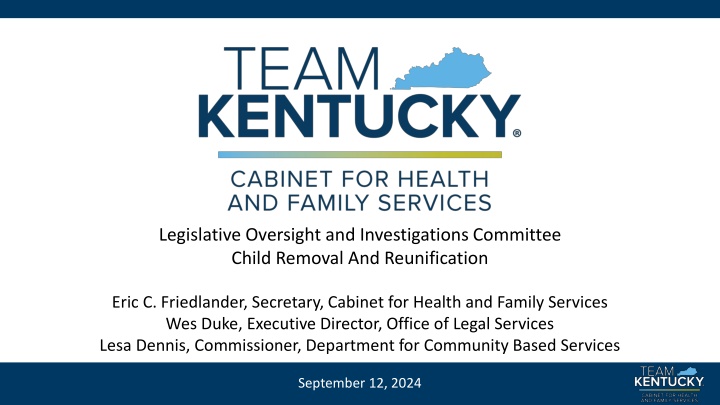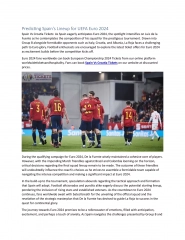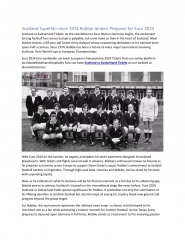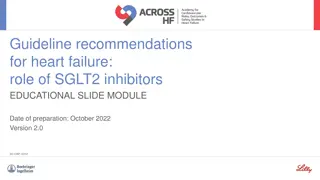
Review of Child Removal and Reunification Procedures
The Legislative Oversight and Investigations Committee conducted a study to review the process of child removal and reunification to ensure procedures are followed properly. Major objectives included examining initial review processes, assessing reunification outcomes, and exploring secondary factors like incentives for Ad-Litem and Court Appointed Counsels. Recommendations focused on evaluating Structured Decision Making tools and enhancing transparency in decision-making processes within the Department for Community Based Services.
Download Presentation

Please find below an Image/Link to download the presentation.
The content on the website is provided AS IS for your information and personal use only. It may not be sold, licensed, or shared on other websites without obtaining consent from the author. If you encounter any issues during the download, it is possible that the publisher has removed the file from their server.
You are allowed to download the files provided on this website for personal or commercial use, subject to the condition that they are used lawfully. All files are the property of their respective owners.
The content on the website is provided AS IS for your information and personal use only. It may not be sold, licensed, or shared on other websites without obtaining consent from the author.
E N D
Presentation Transcript
Legislative Oversight and Investigations Committee Child Removal And Reunification Eric C. Friedlander, Secretary, Cabinet for Health and Family Services Wes Duke, Executive Director, Office of Legal Services Lesa Dennis, Commissioner, Department for Community Based Services September 12, 2024
OBJECTIVES of the STUDY MAJOR OBJECTIVES Review the process for initial review and removal of children to determine if procedures are being followed. Review the child reunification process to determine if children are not returned to their families after case permanency plans are completed. SECONDARY OBJECTIVES The secondary objectives for this study were to review: whether there are incentives for Guardians Ad-Litem and Court Appointed Counsels to prolong out-of-home cases; the feasibility of ending anonymous intake reports; and if there is an appeal process for families whose child has been removed. 2
RECOMMENDATIONS RECOMMENDATION 2.1 The Department for Community Based Services should implement a process and schedule for evaluating all Structured Decision Making tools. Each evaluation should assess the tool's accuracy, its ability to provide data-driven explanation for agency decisions, and its impact on the agency s ability to protect children. DCBS RESPONSE DCBS is committed to the fidelity of the SDM tools. DCBS will continuously work with Evident Change in the analysis of data to improve fidelity and application. Microsurveys are a part of implementation and fidelity monitoring. Analysis of microsurveys will inform opportunities for increased effectiveness of the SDM tools. 3
RECOMMENDATIONS (continued) RECOMMENDATION 2.2 The Department for Community Based Services should review all instances where a supervisor overrode Structured Decision Making tool recommendations. The review should identify necessary changes to improve the agency s transparency in decision-making, including collecting additional facts about cases or modifying TWIST to enable more detailed analyses. DCBS RESPONSE When a social worker completes a request for an override, the supervisor must review and approve the request. Override reason is documented in the narrative. DCBS intends to build an automated selection of an override reason into TWIST but believes accompanying narrative should also be required. The most common reasons for override is child entering DCBS or Relative/Fictive Kin custody or an existing companion case. 4
RECOMMENDATIONS (continued) RECOMMENDATION 2.3 The Department for Community Based Services should provide the Legislative Oversight and Investigation Committee a written update on its progress toward its evaluation of the Structured Decision Making tools by October 2025. DCBS RESPONSE DCBS will implement this recommendation and provide a written update on the implementation and evaluation of Structured Decision Making tools by October 2025. 5
RECOMMENDATIONS (continued) RECOMMENDATION 3.1 The Department for Community Based Services should implement systemic tracking of the completion status of permanency plans throughout an out-of-home care case. These data should be collected and analyzed in aggregate and across years to inform policy, program development, and service delivery improvements aimed at achieving permanency for children. The department should work with the Administrative Office of the Courts to ensure how it tracks such data is compatible with the CourtNet data system. DCBS RESPONSE Significant and expensive TWIST modifications would be required for the suggested data elements and to interface with court information systems that document court actions. DCBS will research this recommendation to determine feasibility. 6
LOIC REPORT CLARIFICATIONS Safety assessments from 2023 included 2,012 cases with blank fields. It is unclear if this was a data issue or an indication the assessments were not conducted All investigations do not require SDM assessments, such as dependency cases, foster parent referrals, and facility investigations. SDM was implemented during this reported time frame. Any referral received prior to implementation (Oct 2022) but completed after implementation (October 2022) would not have a safety assessment. The department adopted a Structured Decision Making (SDM) Safety and Risk Assessment tool in October 2022, replacing the previous Assessment and Documentation Tool (ADT). The ADT was not replaced but was revised with the implementation of the Safety and Risk Assessments. The safety and risk assessment tools were added to the ADT. 7
CLARIFICATIONS The SDM tool focuses on answering two questions: Are there immediate threats to a child s safety and can the child safely remain in the home? What is the potential risk of the child being a victim of maltreatment in the near future? There are two SDM tools, a safety assessment tool and a risk assessment tool. The safety assessment tool assist social worker in organizing information and assessing for immediate threats to a child's safety which supports their decision if the child is safe, unsafe, or can be safe with a plan in their home. The risk assessment tool assesses the likelihood of the child/family being re-referred to the agency, not the risk of future maltreatment. 8
CLARIFICATIONS Table 2.2 outlines how the SDM safety and risk-level assessments can guide investigators in making consistent and informed decisions regarding a child s safety. The SDM recommends closing a case when the child faces no immediate danger and the family can adequately protect them. For cases deemed safe but with moderate risk factors, the tool suggests connecting the family to relevant support services to mitigate identified concerns. In cases classified as safe but presenting high risk factors, the SDM recommends an ongoing in-home case with intensive supervision and support to protect the child. Alternatively, if the family agrees to actively address identified risks under DCBS monitoring, the SDM may recommend a Safe with a safety plan classification. Finally, when a child is determined to be unsafe, the tool recommends removal and initiating an out-of-home case. Safety Assessment identifies the immediate safety threats present that could require immediate action by the child welfare agency. Risk Assessment is utilized to determine the likelihood that a family would be re-referred to the child welfare agency within 18 months and guides what services a family should be referred. A case action is based on a combination of results of the safety assessment and the risk assessment. The worker can override the recommended decision based on valid reasons. 9
CLARIFICATIONS Table 2.4 Number Of DCBS Overrides of SDM Recommendations DCBS RESPONSE There are many reasons for overrides to the SDM recommendations, which include relative/fictive kin placements, companion cases, judicial action, and static factors. DCBS conducted a review of 956 cases that had an overridden decision. The common reasons for overrides in the sample were: Presence of a companion case that remained open - Unsafe and Close Child placed with relative or fictive kin and not in DCBS custody - Unsafe and In Home Child placed in DCBS custody - Safe but with an OOHC flag 10
CLARIFICATIONS DCBS stated it had no current formal policy on how the tools will be assessed and analyzed for effectiveness. DCBS RESPONSE Evident Change assists DCBS with the analysis and development of data management and implementation reports that will assist DCBS staff with monitoring the fidelity of the assessment tools. The implementation reports examine how the SDM assessments are completed and applied in practice to identify areas of strength and opportunities for improvement concerning assessment completion and use. Microsurveys are administered to reflect the extent to which staff and supervisors consider certain factors as barriers or facilitators to integrating assessments with practice. DCBS will continue to work with Evident Change in the application and evaluation of the SDM tools. 11
Questions? 19


















